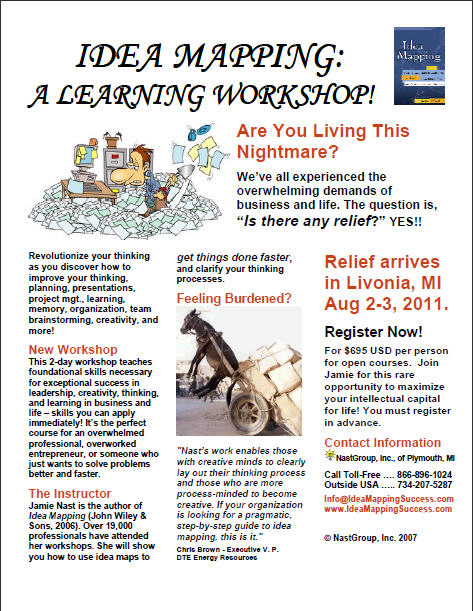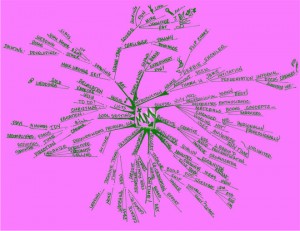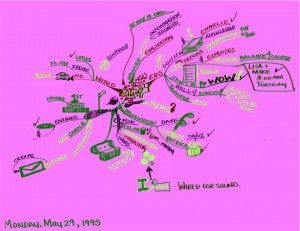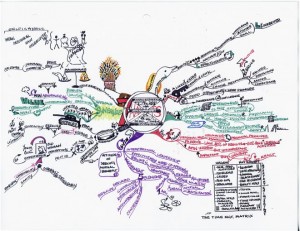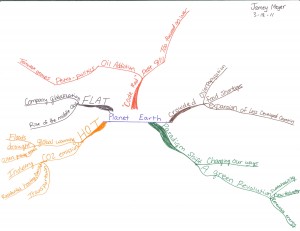An Idea Mapping Success Blogs Weblog
Jamie’s Portrait Drawing from a 1992 Mind Mapping Workshop.
4 Aug 2011 Author: Jamie Nast In: Idea Mapping Workshops, mind mapping workshops, Portrait Drawings In February of 1992 I was a participant in a 2-day Mind Mapping Workshop for the first time. It was taught by one of my colleagues Randy Raines. For many of the activities Randy had us apply a learning model to learn new skills that quite frankly most adults think of as impossible tasks. Drawing a portrait of a human face was one of those daunting undertakings.
In February of 1992 I was a participant in a 2-day Mind Mapping Workshop for the first time. It was taught by one of my colleagues Randy Raines. For many of the activities Randy had us apply a learning model to learn new skills that quite frankly most adults think of as impossible tasks. Drawing a portrait of a human face was one of those daunting undertakings.
I was shocked at how well I did considering I had never drawn anything close to this. With about 10 minutes of instruction we were left to draw for the next 50 minutes. I spent every spare minute and breaks to continue to draw — I was that engrossed in the process. Three or four more hours on my own and I was done. No one could believe I drew the portrait … and that’s the same response my Idea Mapping Workshop participants get from their friend, family and colleagues.
Let me be clear that learning to draw was probably not going to change my life significantly. However the ability to break through a learning hurdle became a significant analogy that I could apply to other learning situations. The Idea Mapping Workshop that I have now been teaching since 1992 contains 5-6 activities that are each very different, but can have similar outcomes as participants amaze themselves by learning skills they thought they could never master.
I’ve shared many portrait drawings in this blog from my Idea Mapping Workshop participants. If you would like to see more, search on “Portrait Drawing.”
Dr. Tim Schweizer’s Article on the Idea Mapping Experiment at Luther College Gets Published.
28 Jul 2011 Author: Jamie Nast In: Articles, Idea Mapping Conference Events, Idea Mapping Practitioners Decorah, Iowa is the home of Luther College and where I first introduced Dr. Tim Schweizer and his subsequent idea mapping experiment with his collage business students. You can read some background on the first experiment in the Oct. 23, 2009 posting. The May 19, 2010 posting shows Dr. Schweizer’s new twist on this experiment which has successfully continued through to the present time. He first presented this paper at an international conference in Spain. Tim will also be speaking at a conference in St. Louis, MO in September where he will teach others how he teaches Idea Mapping to his students.
Decorah, Iowa is the home of Luther College and where I first introduced Dr. Tim Schweizer and his subsequent idea mapping experiment with his collage business students. You can read some background on the first experiment in the Oct. 23, 2009 posting. The May 19, 2010 posting shows Dr. Schweizer’s new twist on this experiment which has successfully continued through to the present time. He first presented this paper at an international conference in Spain. Tim will also be speaking at a conference in St. Louis, MO in September where he will teach others how he teaches Idea Mapping to his students.
If you follow this blog you have seen (I’m guessing) over 70 idea mapping examples from these students on various topics. If you want to see some of these examples, search on “Luther College.” In this recent publication, Tim shares the results of introducing Idea Mapping into the business curriculum at Luther College.
I’ve never seen a professor more successfully introduce this to students and more passionate about how this tool will impact not only their academics, but also their business success. Thank you Tim for making such an impact in the lives of your students.
If you are interested in purchasing the article, it was published by The International Journal of Technology, Knowledge and Society. The cost for the 15-page printed version is $10 and $5 for the electronic version. If you are an educator this article is a MUST.
Public Idea Mapping Workshop Scheduled for August 2-3, 2011
20 Jul 2011 Author: Jamie Nast In: Idea Mapping Workshops, mind mapping workshopsRegistration is now open. I look forward to having you join me for this exciting workshop. See you there!
Idea Mapping is a Learning Journey. Your Style Will Evolve as Did Debbie Showler’s.
19 Jul 2011 Author: Jamie Nast In: Certified Idea Mapping Instructors, Debbie Showler, Idea Mapping Example, Mind Mapping ExamplesDebbie Showler is a CIMI (Certified Idea Mapping Instructor) and a Principal Instructor for the Masters Certificate Program taught by Atocrates, Inc.from Whitby, Ontario.
Today I want to encourage those of you who are newer to Idea Mapping. I realize many of the examples shared in this blog are very beautiful and it can be frustrating as a beginner if you set some of these examples as your standard. My idea maps pale in comparison to some of these. You have to remember that the most important thing is that your maps are functional for the purpose leading you to create them. That being said, everyone develops a style that emerges over time. So let’s take Debbie as an example.
The attached idea maps from Debbie are in a sequential order over time. The top map was created in 1992. You can see that it’s mostly black and white. The lines are straight, few images and some of the writing is upside down. The second example created that same year included color, but still not many images.
Many idea maps later example #3 begins to show what is now closer to her emerging style. This “to do” map was from 1993. Debbie’s forth example came hundreds of maps later. What’s special about this one is that it uses more images than words. This was used as the primary communication tool to share and support this organization’s corporate vision. Copies of this map were then distributed to the team members.
The next map was a summary of an article about Stephen Covey’s Seven Habits. It has amazing detail and combines words and imagery beautifully. I can’t remember what year this was, but I’m going to guess it was 2005. Finally the last example was created while she watched an Oprah show titled “The Secret Behind the Secret.” What’s so exciting about this one is that it was created live — right as the show was happening. Click on the map to see an enlarged view and you can see the details.
So as you do more mapping keep some of those you did early in your learning process and enjoy watching your style unfold.
- 0 Comments
- Tags: An Idea Map of The Oprah Show - The Secret Behind the S, Atocrates Inc, Certified Idea Mapping Instructor, Corporate Vision, Debbie Showler, idea mapping examples, live idea mapping, Mind Mapping Examples, Oprah, Real-Time Idea Mapping, Stephen Covey, The 7 Habits of Highly Effective People, The Secret, The Seven Habits of Highly Effective People
More Idea Maps from Luther College Students. Idea Maps #290 & 291.
15 Jul 2011 Author: Jamie Nast In: Book Reviews, Idea Mapping Example, Mind Mapping ExamplesThe very first posting about this experiment with Luther College students was on October 23, 2009. (You can get some background there.) Dr. Tim Schweizer (who took my Idea Mapping workshop in August 2009) led the experiment. Every semester since then Tim has taught Idea Mapping to his Principles of Management students at the beginning of each semester. Each student reads the first 5 chapters of my Idea Mapping book and then Tim teaches them the “how to’s.”
During one of the activities the students randomly pick one book from the box of books pre-selected by Tim and then read. After 40 minutes of reading they have 15 minutes to map their thoughts. The instructions were that the idea maps were not supposed to be summaries, but they would be reflection pieces on the reading.
So today I’m sharing two Idea Maps from students who attended the Spring semester. The first one was created by Emily Streeper on the book “The Dilbert Principle” by Scott Adams. The second example was done by Jamey Meyer on the book “Hot, Flat, and Crowded” by Thomas L. Friedman. Thanks to both for sharing.
To see more examples from these students search this blog for “Luther College.”
Answers to the July 8, 2011 Name Tent Puzzles
11 Jul 2011 Author: Jamie Nast In: Name Tent ActivityThis fun activity is the introduction to my Idea Mapping Workshops. Participants draw their names similar to the game of Concentration. For more background on the purpose of this activity read the first posting on this topic. This posting is sharing the results of the drawings posted on July 8, 2011.
If you want to be challenged to guess other name tents from this blog, search on “name tent”. The names in the June 9, 2011 posting were especially challenging if you want to try to guess those as well.
Answers: Les and Alfred
Name Tent Activity. Can You Guess These Names?
8 Jul 2011 Author: Jamie Nast In: Name Tent Activity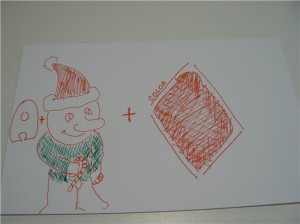 In August of 2008 I introduced the first posting about an activity I use to introduce participants to each other in my Idea Mapping Workshops. Read the first posting to understand the purpose and background of this activity.
In August of 2008 I introduced the first posting about an activity I use to introduce participants to each other in my Idea Mapping Workshops. Read the first posting to understand the purpose and background of this activity.
Can you guess the first names of these two people from their drawing? I’ll share the answers in the next posting. If you want to be challenged to guess other name tents from this blog, search on “name tent”. The names in the June 9, 2011 posting were especially challenging if you want to try to guess those as well.
Idea Map #289 – My First Idea Map or Mind Map that Saved Me at Least a Week’s Worth of Time.
5 Jul 2011 Author: Jamie Nast In: Idea Mapping Example, Mind Mapping Examples Early in 1996 I was certified to teach Stephen Covey’s “7 Habits of Highly Effective People” workshops for leaders with EDS (Electronic Data Systems). On a late Friday afternoon in August I was facing the daunting task of teaching my first two 4-day Covey workshop in Indianapolis with one of my co-workers Lisa Morgan. Unfortunately I hadn’t touched the material since the certification, so I grabbed the 3-inch instructor manual and prepared myself for what seemed to be an impossible feat of preparing for next week’s classes. Then I had an idea!
Early in 1996 I was certified to teach Stephen Covey’s “7 Habits of Highly Effective People” workshops for leaders with EDS (Electronic Data Systems). On a late Friday afternoon in August I was facing the daunting task of teaching my first two 4-day Covey workshop in Indianapolis with one of my co-workers Lisa Morgan. Unfortunately I hadn’t touched the material since the certification, so I grabbed the 3-inch instructor manual and prepared myself for what seemed to be an impossible feat of preparing for next week’s classes. Then I had an idea!
The reality that I could not be ready to teach hit me hard, so I proposed an idea to Lisa. The two Indianapolis workshops were structured so that the first class would attend on Tuesday and Thursday and the second class would attend Wednesday and Friday. Then we would repeat that pattern the following week to wrap up the 4 days for both groups. My thought was to let her teach the first day of the first class while I sat in the back. At that point I had been teaching and utilizing mind mapping (pre-idea mapping days) for over 4 years. So while she taught, I was going to simultaneously mind map every detail of the course in preparation to then teach the following day for the start of the second class. She agreed with the plan.
It worked like a charm. The attached map is the original that I created the first day while Lisa taught. It includes every detail necessary for me to teach. The following day I taught from this 11″ x 17″ single piece of paper. We repeated this strategy for the remaining 3 days of both workshops. I saved at least a week’s worth of studying and for the first time I personally experience the power of Idea Mapping to a degree I had not up to this point.
Lessons: Until you personally experience the power of Idea Mapping it’s a nice tool but it might not be one you use frequently. The scenario doesn’t need to be of this magnitude, but there needs to be one. I understood the value of the tool, but this solidified it even more for me.
Kaye Nightingale Attests to the Power of Idea Mapping
29 Jun 2011 Author: Jamie Nast In: idea mapping book, Testimonials Kaye Nightingale is a Microsoft Master Instructor and NVQ Assessor/Internal Verifier who has developed a reputation for being technically-minded but people-focused and specializes in helping busy people achieve more in less time. In addition to her incredible achievements she has become an expert Idea Mapper!
Kaye Nightingale is a Microsoft Master Instructor and NVQ Assessor/Internal Verifier who has developed a reputation for being technically-minded but people-focused and specializes in helping busy people achieve more in less time. In addition to her incredible achievements she has become an expert Idea Mapper!
Kaye’s work with idea mapping has been featured previously in this blog. She recently put up a posting on her own blog. In the comment section of her posting she shares a significant testimonial about how she has been able to use this tool to achieve significant success and productivity. It is powerful enough to make any want to learn this skill. I think you will be interested.
The idea map of my Idea Mapping book that she refers to can be found in my Oct. 6, 2007 posting.
Another Free 1-hour Idea Mapping or Mind Mapping Webinar Recorded by RMC Project Management Bookstore.
24 Jun 2011 Author: Jamie Nast In: Webinars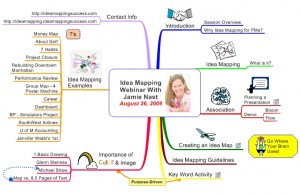 In the May 29, 2011 posting I shared a link to a webinar recorded for IIBA (International Institute of Business Analysis). I was invited to be a guest presenter because my Idea Mapping book is one of the best sellers in their library of recommended reading.
In the May 29, 2011 posting I shared a link to a webinar recorded for IIBA (International Institute of Business Analysis). I was invited to be a guest presenter because my Idea Mapping book is one of the best sellers in their library of recommended reading.
For some reason there are a few of you that have been unable to view the webinar from your computer. It works fine for me, so I don’t know what’s happening. Therefore I wanted to provide you with a link to a similar webinar I did for RMC Project Management Bookstore back in August of 2009. This event had 873 project managers in attendance. PMP’s (Project Management Professionals) can receive 1 PDU by viewing this archived version.
If you have any troubles viewing this, please let me know. The attached Idea Map is the overview of this webinar created in MindManager by Mindjet.
Idea Mapping Blog
The purpose of this blog is to share idea mapping examples and related learning from my Idea Mapping, Memory, Speed Reading, and Certification Workshops. This blog is dedicated to my Certified Idea Mapping Instructors, my clients, Mind Mapping and Idea Mapping practitioners around the globe.
![[Ask]](http://ideamapping.ideamappingsuccess.com/IdeaMappingBlogs/wp-content/plugins/bookmarkify/ask.png)
![[del.icio.us]](http://ideamapping.ideamappingsuccess.com/IdeaMappingBlogs/wp-content/plugins/bookmarkify/delicious.png)
![[Digg]](http://ideamapping.ideamappingsuccess.com/IdeaMappingBlogs/wp-content/plugins/bookmarkify/digg.png)
![[Facebook]](http://ideamapping.ideamappingsuccess.com/IdeaMappingBlogs/wp-content/plugins/bookmarkify/facebook.png)
![[Google]](http://ideamapping.ideamappingsuccess.com/IdeaMappingBlogs/wp-content/plugins/bookmarkify/google.png)
![[MySpace]](http://ideamapping.ideamappingsuccess.com/IdeaMappingBlogs/wp-content/plugins/bookmarkify/myspace.png)
![[Slashdot]](http://ideamapping.ideamappingsuccess.com/IdeaMappingBlogs/wp-content/plugins/bookmarkify/slashdot.png)
![[Sphinn]](http://ideamapping.ideamappingsuccess.com/IdeaMappingBlogs/wp-content/plugins/bookmarkify/sphinn.png)
![[StumbleUpon]](http://ideamapping.ideamappingsuccess.com/IdeaMappingBlogs/wp-content/plugins/bookmarkify/stumbleupon.png)
![[Technorati]](http://ideamapping.ideamappingsuccess.com/IdeaMappingBlogs/wp-content/plugins/bookmarkify/technorati.png)
![[ThisNext]](http://ideamapping.ideamappingsuccess.com/IdeaMappingBlogs/wp-content/plugins/bookmarkify/thisnext.png)
![[Twitter]](http://ideamapping.ideamappingsuccess.com/IdeaMappingBlogs/wp-content/plugins/bookmarkify/twitter.png)
![[Webride]](http://ideamapping.ideamappingsuccess.com/IdeaMappingBlogs/wp-content/plugins/bookmarkify/webride.png)
![[Email]](http://ideamapping.ideamappingsuccess.com/IdeaMappingBlogs/wp-content/plugins/bookmarkify/email.png)
